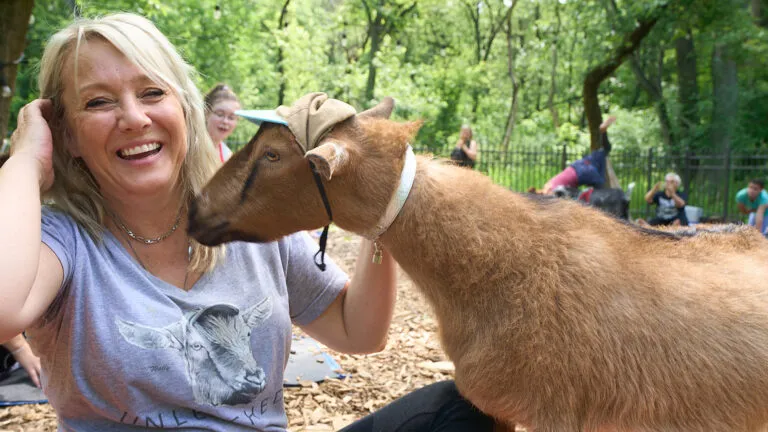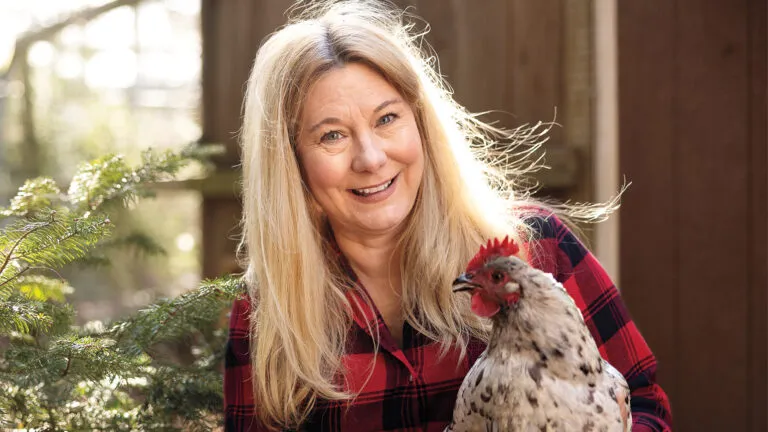My dog, QT Pi (“Cutie Pie”), tucked his little white paws under his body and trembled in my arms. As a veterinarian at VCA North Idaho Animal Hospital, I’m usually the one easing pet parents’ fears, but on that day six years ago, I couldn’t calm my own. Or my dog’s.
QT Pi is my heart dog, the one who always wants to be by my side. A Chihuahua–Jack Russell–dachshund mix, he is two dogs long and a half dog tall. I’d adopted him from a litter of shelter puppies that had distemper. He had spent a week in intensive care at Washington State University College of Veterinary Medicine, my alma mater. Afterward, I had taken care of him at home.

2022 issue of Guideposts
Now I’d brought QT Pi to the clinic for the first time. He was there for a dental cleaning, a procedure that required general anesthesia. When I walked in and tried to hand him over to my colleague, he clung to me, panting and shivering. I kissed his nose. “You’re going to be fine,” I said, wishing he understood. He whimpered as I peeled him away and stepped outside.
I found myself shaking too, and it wasn’t just that I was anxious because there’s a risk of an adverse reaction anytime an animal is put under anesthesia. The fear that my little dog felt hit me someplace deep inside. What was going on here? I took a slow breath in and out. The last time I felt like this was at that lecture….
I’d wanted to be a veterinarian ever since I was a young boy growing up on a dairy farm in Idaho. I graduated from veterinary school in 1980 and went into practice in southern Idaho. My career grew. My wife, Teresa, and I moved halfway up a mountain in northern Idaho in 1997, to a horse ranch that we call Almost Heaven Ranch.
In 1996, I received the wonderful opportunity to become the veterinary correspondent for Good Morning America. I joined the team at the Dr. Oz Show in 2009.
I’d been practicing veterinary medicine for almost three decades by then, and I was thinking about retiring. Then at a conference that year, I went to a lecture by famed veterinary behaviorist Dr. Karen Overall. It had been a busy conference, and I was tired. I stood up, thinking I’d slip out early.
“Fear is the worst thing a social species can experience,” I heard Dr. Overall say. I stopped short.
“It causes permanent damage to the brain.” I turned and sat back down.
Dr. Overall explained that pets are like one-year-old children. She asked us to imagine being taken against our will, having no control, being unable to escape, feeling pain that we couldn’t understand. “Think back to a time as a child when you felt manhandled, threatened or abused,” she said.
The memories came flooding back, memories I thought I’d put behind me. My two sisters, brother and I were in the car returning home from a trip to the grocery store with our mom. We chanted a little verse we’d made up: “Daddy’s in a huffy puff. Daddy’s in a huffy puff.”
We were too young to understand, but our father was in the grip of two diseases that would go undiagnosed and untreated until later in his life: alcoholism and bipolar disorder. We never knew what kind of state we’d find him in.
The house was quiet as we unpacked the groceries. I thanked my lucky stars that he was nowhere around. Later that night, as I huddled in my bedroom just off the kitchen, I heard Mom and Dad fighting. Again.
“Outta my way!” Dad yelled. The angry words escalated. Things crashed, and Mom screamed. I shivered under the covers. “I’m going to kill you!” Dad bellowed. I could feel his rage through the thin walls. I was so frightened, I couldn’t move. Mom started crying. A door slammed. The fight was over, for now. But I knew there would be more.
I’d lived with that fear throughout my childhood. In the car when Dad drove, zipping down dirt roads at a hundred miles an hour while I clung to my seat for dear life. Or when I played in the fields, barely old enough to tie my own shoes, and Dad would push me up onto the driver’s seat of the hay baler, and laugh when I screamed, terrified, because I couldn’t handle the huge machine.
Traumatic childhood experiences can teach resilience. I became a high achiever, striving for top grades in school and, later, for the biggest market share for the veterinary hospitals I owned. I was very competitive and never wanted to show weakness.
Even in my personal life, I was driven. Teresa and I married in my third year of veterinary school, and we built the stable, happy family I’d longed for as a boy. A pastor friend helped me learn to accept the pain of my past. I came to trust in the love of God, the father who would never fail me. My positive, high-energy, can-do self shielded my vulnerabilities so well that I almost forgot I had them.
Until Dr. Overall’s lecture drew them to the surface again.
I’d always done my best for my patients. Looking back, however, I hadn’t always recognized the signs of fear: shivering, shaking, yawning, panting, salivating, leaning away, glancing at the door, even biting.
When I’d seen a dog lie perfectly motionless on the exam table, I thought he was calm. Dr. Overall explained that he was likely paralyzed with fear. The way I had been the night I’d heard my dad yelling that he was going to kill my mom. Just recalling it made me feel shaky, as vulnerable as a child again.
If fear still had such a hold on me even though I could talk to a counselor and lean on the comfort of my faith, how must it be for helpless animals? The animals whose suffering I’d promised to prevent and relieve when I took my veterinarian’s oath?
I had to face the truth: Although I had the best of intentions, there were times I had actually caused my patients trauma. Back in veterinary school in the late 1970s, we didn’t receive training in animals’ emotional well-being. The focus was on their physical health. Even pain management was pretty basic.
I knew God had nudged me to stay at that lecture for a reason. Genesis says God gave us humans dominion over the fish of the sea and the birds of the air and every living thing that moves upon the earth. He entrusted animals to our protection and care. I wanted to do better by them. “Show me a better way to treat animals,” I asked God. “A way free of fear.”
I couldn’t retire yet. I had more to learn, to do. I talked to and studied the work of veterinary behaviorists. Alleviating fear would improve the well-being of both pets and their people.
Not only could fear and anxiety in cats and dogs mask other health problems, but these emotions were also at the root of most aggressive behaviors. Behaviors that could destroy the human-animal bond and lead to abandonment, relinquishment or euthanasia.
I experimented using treats and toys to distract pets from procedures. I researched FAS (fear, anxiety and stress) pheromones, chemical signals animals give off that send a message to others of the same species.
That’s what QT Pi must have sensed from the other dogs at the clinic entrance, I thought now, as I waited for my dear little dog to be done with his dental procedure. He was so bonded to me that he’d picked up on my fear, anxiety and stress too. God was nudging me again, as he had at the lecture, reminding me of my vulnerability in order to galvanize me into action. It was time to put my ideas into practice.
The next week, when QT Pi and I returned to the clinic for his vaccinations, I made sure the outside area was cleaned to remove FAS chemicals and then spritzed with pheromones that would evoke a calming response. Because he’d balked at the front door, I brought in QT Pi through the side door, where he hadn’t formed any unpleasant associations. There was no shivering, no trying to escape!
In the exam room, he squirmed at the sight of the big metal table, so I set him on the floor and got down beside him. His ears perked, and his tail wagged. I’d brought him in hungry, so he’d respond better to food rewards. As my colleague readied the syringe, I used a can of spray cheese to write “QT Pi” on a bumpy rubber pad called a licky mat. He licked his name off the mat and barely noticed when he got his injection. I hugged him close, and he kissed my face. What a difference!
From then on, I was committed to implementing my new techniques and teaching them to others. I worked with veterinary behaviorists to enhance the emotional well-being of pets in all aspects of their lives. In 2016, I formally launched the Fear Free Certification Program, an online course designed to help veterinary professionals eliminate fear, anxiety and stress and create a more rewarding experience for all.
Today more than two thirds of all veterinary students graduate Fear Free–certified. Plus, we have Fear Free programs for pet professionals (such as groomers and dog sitters), shelters and pet parents.
None of this would have happened if God hadn’t put me where I would hear what I needed to hear and feel what I needed to feel. Reliving the pain and fear of my past showed me that vulnerability is a strength, not a weakness. It gave me a deeper empathy for and understanding of the animals God has given us to love and care for—animals who, like my QT Pi, love and care for us right back.
Read Dr. Becker’s Fear Free tips for pet parents
For more inspiring stories, subscribe to Guideposts magazine.





